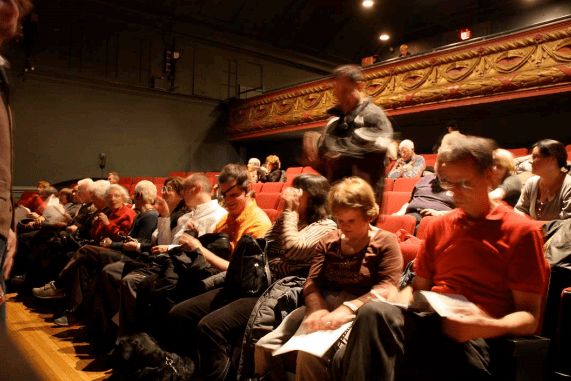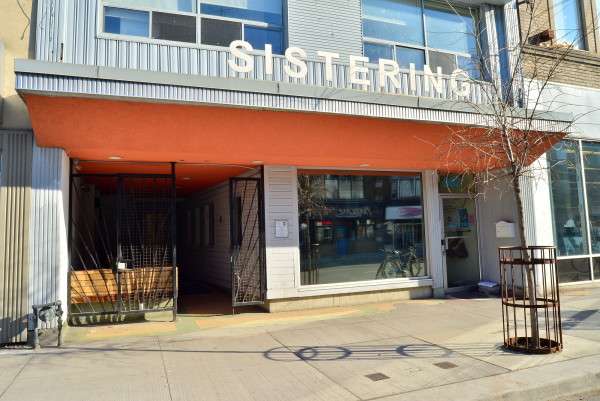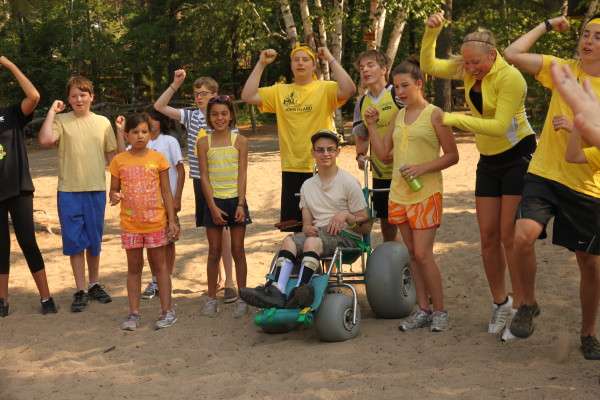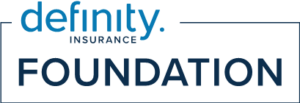
Blog
Raising the Curtain on Accessibility: Resources from the performing arts – Archived Content
Image: Blind patrons among the audience enjoying audio described performance of Bethune at Factory Theatre
Over the last year, ONN has been sharing accessibility resources from across Ontario through the EnAbling Nonprofits project. Sharing knowledge and putting accessible practices in place doesn’t just help us comply with accessibility laws, it strengthens our relationships with other nonprofits and our communities.
In October, Rose and I joined the panel “Leading a Culture of Accessibility” at ONN’s annual conference to share how a collaboration helped us reach new audiences (and build stronger relationships with our existing audiences). In 2009, Creative Trust worked alongside Rose Jacobson at Picasso PRO to launch a pioneering program to open up Toronto’s theatres to Blind/low-vision and Deaf/hard of hearing audiences. What we learned over the next two years is relevant to any organization working towards truly opening their spaces and events to everyone, regardless of abilities.
We wanted to help theatre, music and dance companies immediately become more accessible (even if their facilities were not yet barrier free) by warmly welcoming patrons who required communications access and allowing them to fully enjoy performances. The centrepiece of our Sun Life Performing Arts Access Program was a pilot series of live audio described (AD) and American Sign Language (ASL) interpreted performances designed to help and encourage theatre, dance and music companies to integrate these services into their own organizational cultures and programming.
Our people became our greatest assets. The work started with Rose overseeing the training Audio Describers in the art of live description (which brings sets, lighting, costumes, and action alive for Blind and visually impaired audience members through a wireless transmitter to an earpiece worn by patrons.) We enhanced this work by creating a support team of Deaf Theatre Advisors, Deaf Masters and Interpreters for companies offering American Sign Language interpretation as a component of onstage performances.
Toronto has a large, diverse, and active Deaf and disability community that continues to grow as our population ages. Access enables them to participate more fully in Toronto’s cultural life, and accessible programming enables theatres to develop new audiences from within these communities. By the end of the pilot project, more than 100 new audience members attended Factory Theatre’s AD and ASL productions alone. Headsets were booked to the maximum for each audio described show and patrons offered generous post-show feedback– they want these opportunities to continue.
The two years dedicated to this project were not enough to bring about a complete systems change, even in a world which increasingly reflects the values of diversity and inclusion. But we’ve recently been encouraged by companies that are slowly, but surely, taking up these challenges and joys. We have a long way to go in Canada, certainly not just in the performing arts– we lag far behind other countries in supports and policies for people with disabilities. Alex Bulmer, a Blind theatre artist and one of the founders of Picasso PRO, pointed out that “In Britain people think people are disabled by the environment, not by their medical condition.”
Among the lasting impacts of the Performing Arts Access Program are two handbooks for producers and presenters of Audio Described and American Sign Language interpreted performances and events. These practical toolkits provide step by step guidance for anyone planning to open their nonprofit’s programming to Deaf/hard of hearing or Blind/low vision attenders.
Download the Resources
The Performing Arts Access Program Handbook – Part I (Audio Description)
The Performing Arts Access Program Handbook – Part II (American Sign Language Interpretation)
The circulation of resources such as these, along with continually sharing our learnings about accessibility, allows us to work toward the systemic change that would otherwise not be possible with short-term projects. Where do you foresee AD and ASL fitting into your work? What resources does your nonprofit rely on to learn about accessibility?
This Blog post was written as a case study for the EnAbling Nonprofits Ontario, an EnAbling Change project with the Government of Ontario.






